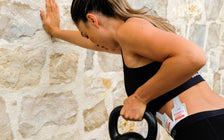Osteoporosis is a condition where the density of your bone tissue reduces, becoming “porous”, and increasing the risk of bone fractures.
Osteoporosis affects more than 200 million people globally. In fact, the International Osteoporosis Foundation estimates that 1 in 3 women over the age of 50 years and 1 in 5 men will experience osteoporotic fractures at some point in their lifetime (1).
Bone health is important at every age - your bones grow as a child and teenager and reach peak bone mineral density (BMD) by your late 20s. Your BMD starts to decrease from about 40 years old, especially during menopausal years, and can lead to osteoporosis.
Maximising your bone mineral density with good nutrition in your early life helps to prepare your bones for the effects of ageing.
Signs & symptoms of osteoporosis
Osteoporosis is often described as a silent disease, going undetected until someone has a fall or fracture. Fractures associated with osteoporosis are most commonly at the hip, spine and wrist. Signs and symptoms may include:
- Back pain, caused by a fractured or collapsed vertebra
- Loss of height over time
- A stooped posture
- A bone that breaks more easily than expected e.g. a minor bump or fall resulting in an injury
Getting a diagnosis
If you have a fractured bone and you’re middle-aged or older, you should ask your medical practitioner to investigate whether your BMD status is the underlying cause.
Osteoporosis is typically diagnosed using a DEXA bone scan, which measures bone mass and density using a measurement called a T-score. The lower the T-score, the lower your bone mass is.
Your medical practitioner will be able to explain your bone density status and how it can be managed with nutrition, exercise, lifestyle and perhaps medication.
You can usually request a DEXA scan via your GP or private health provider if you are in a high-risk group e.g. due to family history or a health condition that puts you at risk of osteoporosis. Some specialists may offer a trabecular bone score test which assesses bone quality.
What causes osteoporosis?
Throughout life, bone is constantly renewing in a process called bone remodelling. Maintaining the correct balance between replacing new bone and losing old bone is key to building strong healthy bones.
The bone remodelling process involves different types of bone cells and phases to keep your skeleton strong. The cells work within three phases of bone remodelling: Activation – Resorption – Bone Formation. This is a continual process that goes on throughout your life and needs support with nutrition, exercise and healthy lifestyle factors.
As people age, bone mass is lost faster than it's created. For people with osteoporosis, more bone is lost than replaced. This means that bone mineral density decreases, the bones gradually become brittle and are more likely to break.
Other risk factors that can increase the risk of osteoporosis and fracture include (10) (13):
- Having a Body Mass Index (BMI) below 21
- Smoking
- Alcohol Consumption
- History of oral glucocorticoid medication
- Rheumatoid arthritis
- History of falls
When you're pregnant, your resources are used to build the foetal skeleton, meaning your calcium levels and bone metabolism are altered. Bone mass is usually restored several months after childbirth when the breast-feeding phase is complete. Although pregnancy and lactation-induced osteoporosis is a rare disease, it’s key to pay extra attention to nutritional requirements during this time (11).
During ages 65 to 70, both men and women lose bone mass at the same rate. As we age, absorption of calcium also decreases in both sexes (7).
Stages of osteoporosis
Osteoporosis develops gradually, often with no visible symptoms. The medical profession categorise the development of osteoporosis in four stages:
Stage 1 - Equilibrium
Bone resorption and new bone formation reach an equilibrium in your 20s to 30s, meaning that you start to lose and form bone at the same rate. This is the first stage of osteoporosis because bone growth is no longer outpacing bone loss. At this stage, it’s likely that your bone density scores (T-score) will be normal and range from +1 to -1.
Stage 2 - Osteopenia
Osteopenia means your bone density is lower than the average adult. At this stage, bone loss is faster than bone growth. This is a normal part of the ageing process; the rate of bone loss can also vary depending on your genetics, environmental and dietary factors. If you experience an injury or have a bone density scan done for another reason, you might be diagnosed with osteopenia. T-scores during this stage range from -1 to -2.5.
Stage 3 - Osteoporosis
A diagnosis of osteoporosis is when your T-scores are -2.5 or lower. You are at a higher risk of breaks and fractures even from simple injuries, bumps or falls. Typically people in this stage are in mid-life or older as this is the time of life when the breakdown of bone occurs at a faster pace.
Stage 4 - Osteomalacia
This is a more severe form of osteoporosis. You may experience signs and symptoms such as kyphosis (bent over appearance) and pain during everyday activities. In this stage, T-scores are well below -2.5 and you may have had one or more breaks or fractures (2).
Osteoporosis and menopause
Menopause sees a critical period of change in the bone strength of women, which sets the stage for development of osteoporosis post menopause. This transition takes place over a three year period with BMD declining around one year prior to the final menstrual period. BMD continues to decrease in early menopause for approximately two years following the final menstrual period.
There are two phases of bone loss in women: the first occurs mainly in trabecular bone, starting at menopause. After 4-8 years, the second phase (age related bone loss) is a persistent, slower loss of both trabecular and cortical bone, and is mostly attributed to reduced bone formation.
The average reduction in BMD is about 10% during the menopause transition, however it’s estimated that half of all women may lose as much as 20% BMD in this phase. Additionally, 25% of postmenopausal women can be classified as fast bone losers (3) (4).
Oestrogen promotes osteoblast activity – the cells that create bone growth and renewal. When oestrogen levels drop during menopause, the osteoblasts are unable to effectively produce bone (5).
Approximately 30% of all postmenopausal women in Europe and the United States are reported to have osteoporosis, and at least 40% of these women will sustain one or more osteoporotic fractures.
The menopause transition represents a time-limited window of opportunity to intervene in rapid bone loss and damage to minimise the risk of osteoporosis in later years (6) (9).
What to do for osteoporosis
Optimise Nutrient Status
Calcium, vitamin D, collagen, magnesium and various trace elements are all vital in the bone remodelling process and work in synergy together.
Calcium
Calcium is the main building block of bone. 99% of the calcium in your body is stored in your bones and teeth. If you're deficient in calcium from your food, then your body will use calcium from your bones for other functions and this may compromise bone health.
Food sources of calcium include milk, cheese, sardines, dark green leafy vegetables, nuts, and seeds.
Vitamin D and K
An optimal vitamin D status is vital as it supports the active absorption of calcium and helps to prevent excessive activation of osteoclasts, the cells that break down bone. Vitamin D also supports the transport of calcium into your bloodstream, while Vitamin K helps move calcium from your bloodstream to help build bone and collagen. In the absence of vitamin K2 there is a risk that calcium may be deposited in the tissue and arteries and not reach the bone (8).
Food sources of vitamin D include oily fish, eggs, butter and mushrooms.
Vitamin D is made naturally by safe sun exposure to your skin. For optimal vitamin D status, consider taking vitamin D supplements.
Magnesium
Magnesium forms part of your bone matrix, which is made up of proteins, collagen, minerals and bone cells. Magnesium helps transport calcium to your bones and to prevent calcium deposits in your arteries and bone joints (14).
Food sources of magnesium include dark green leafy vegetables, nuts and seeds.
Collagen
Collagen provides the interior scaffolding where your bone minerals are deposited, supporting your bone matrix and bone density. Eating collagen rich foods and adequate protein alongside foods rich in vitamin C, zinc and copper will support collagen production (15).
Trace nutrients, like zinc, selenium manganese, boron and copper, are crucial to your bone remodelling process. Eating a wide range of fruit and vegetables should help provide these trace nutrients (10).
Supportive Exercise
Balancing, weight bearing and progressive resistance exercises are thought to be an effective way to improve multiple risk factors. Exercise should target muscles attached to or crossing your hips and spine, and functionally challenge balance and mobility (6) (8).
Lifestyle Factors
It’s also essential to reduce factors like smoking, alcohol, fizzy soft drinks (13) and caffeine as they can inhibit the bone building process. Also consider how to limit exposure to toxins in the food chain and environment since they can alter the nutrient status of food and disrupt how your body works.
Summary
It’s important to look after your bone health throughout every life stage from your childhood and teens to middle and older age. Building peak bone mass during your younger years will help minimise the impact bone loss has on you as you age.
Taking a multi-faceted approach, focusing on bone-building nutrition (consider food and supplements) and a supportive exercise plan (balance, resistance and progressive weight bearing) is vital to preserve and maintain optimal bone mineral density. Also, minimising exposure to toxins in your food, water and the environment as they may compromise your bone health.
For mid-life women, the menopause transition offers an opportunity to maximise nutrient status and adapt exercise routines to reduce the risk of developing osteoporosis.
Investigate the root cause of pain, injury and fractures with your medical practitioner to find out if bone mineral density is compromised.
Take positive steps to promote a healthy skeleton now – don’t wait until older age.
References
-
Menopausal osteoporosis: screening, prevention and treatment
-
Nutritional Support and Physical Modalities for People with Osteoporosis
-
Magnesium and Osteoporosis: Current State of Knowledge and Future Research Directions
-
Specific Collagen Peptides Improve Bone Mineral Density and Bone Markers in Postmenopausal Women—A Randomized Controlled Study




